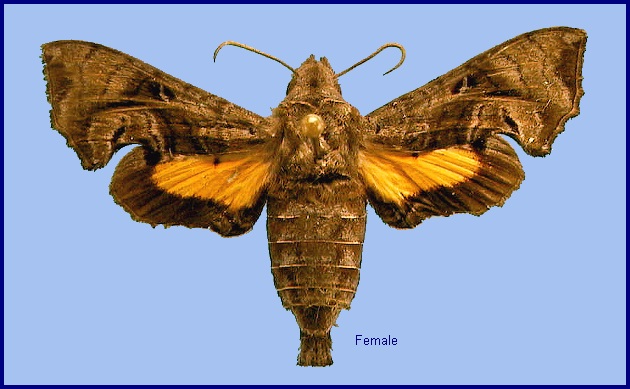
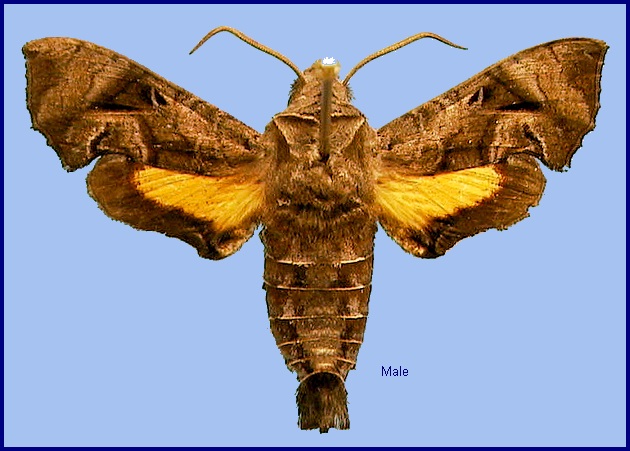
Lophura hyas Walker, 1856, List Specimens lepid. Insects Colln Br. Mus. 8: 107. Type locality: [Indonesia,] Java [Jawa].
Synonym. Lophura hyas Walker, 1856.
Synonym. Macroglossum geometricum Moore, 1858.
Synonym. Perigonia macroglossoides Walker, 1866.
Synonym. Gurelca hyas conspicua Mell, 1922.
[Further details on this species in Japan, as well as photos of many stages, can be found on Digital Moths of Japan.]
Wingspan: 34--40mm. Head, thorax and abdomen greyish-brown; collar and tegula outlined with reddish-brown; abdomen with some reddish-brown, lateral, segmental markings. Forewing greyish-brown, a black spot at base; two pale, indistinct, curved, antemedian lines; a grey streak on discocellulars with a dark, reddish-brown patch on each side of it; two highly angulate postmedian lines with a pale line between them from Cu1 to inner margin, and a reddish-brown streak below M3; a reddish-brown mark on inner margin before tornal angle, a curved submarginal line and a subtriangular dark marginal patch below apex. Hindwing yellow with an annular spot on the discocellulars; a broad, black marginal band of even width along outer margin. Underside of both wings ochreous, much marbled and suffused with brown and reddish-brown (Bell & Scott, 1937).
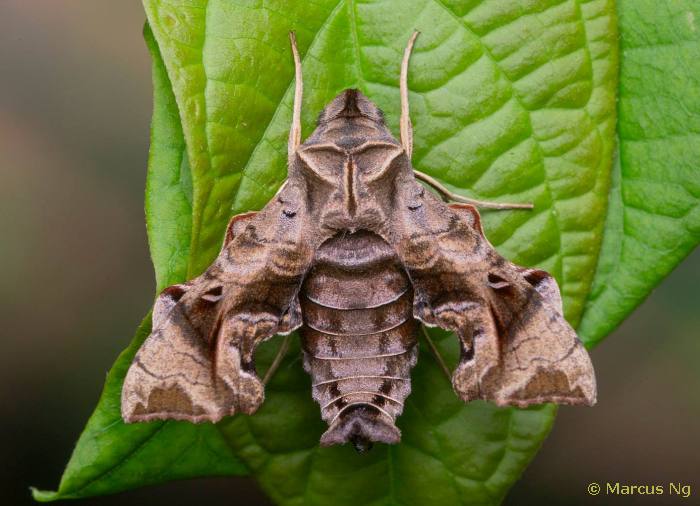
A crepuscular species which visits flowers, particularly Duranta erecta in Hong Kong, before it is fully dark. Blossom within the bush tends to be favoured over that on extended fronds (Tennent, 1992).
China: ii (Hong Kong); iv (Hainan); v (Guangdong); vi-vii (Hainan; Hong Kong); viii-x (Hong Kong); xi (Guangdong). Taiwan: v (Nantou Hsien); vi-vii (Tainan); vii (Tainan Hsien; Pingtung Hsien); viii (Hualien Hsien); ix (Kaohsiung). Japan: 15-17.viii (Ryukyu Archipelago).
OVUM: Initially pale yellowish-green; as the larva develops two band of red appear, which are the dorso-lateral stripes. Slightly oval (1.2 x 1.4mm), shiny and smooth (Bell & Scott, 1937).
The eggs are frequently parasitized by minute wasps, as many as three wasps emerging from one egg (Bell & Scott, 1937).
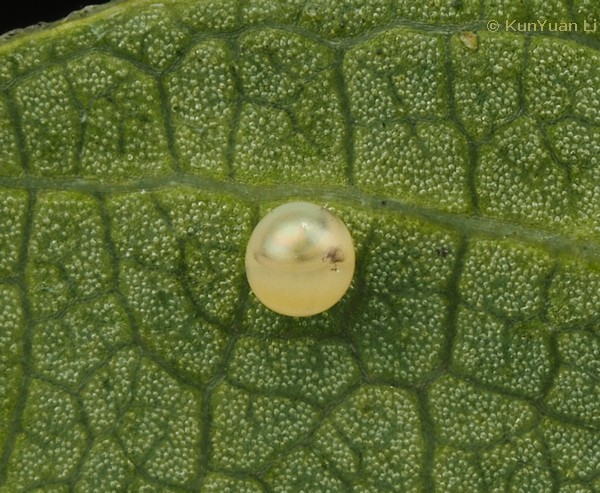
LARVA: Full-fed 50mm, width 7.5mm, horn 7mm. According to Bell & Scott (1937), in the first instar head rounded-quadrate, body cylindrical and of the same diameter as head. Horn thick at base, tip truncate with a small setiferous tubercle at each corner of the truncation. The main hairs bifid on head and trifid on body; with hair-like tubercles on horn. Head and body pale honey-yellow, with a broad, red, dorso-lateral stripe from segment 3 to base of horn. Soon after hatching this stripe becomes violet and the dorsum greyish; horn black. In the second instar, main hairs now simple; head greenish with a dark stripe separating face from cheek. Body pale green, dorsum greyish, with a narrow, dark, dorsal stripe expanding into a circular patch at segment margins. There is a pale dorso-lateral stripe with a purplish suffusion below it on each segment. In the third instar, head brown, body grey marbled with brown, with paler coloured diagonal lateral stripes on segments 5 to 11. There is a pale orange triangular patch below each oblique stripe except on 8 and 9. In the fourth instar, body tapering slightly from segment 5 frontad; horn tapering evenly to a truncate tip; head greyish-white with a white stripe separating face from cheek; body greyish-brown with a pink tinge. There is a white dorso-lateral stripe on 2 to 4, and whitish oblique lateral stripes on 5 to 11, edged above with fuscous, and with orange patches below them as in the third instar. Horn black above, yellow below, with black tubercles.
In the fifth and final instar, head nearly oval in shape; true clypeus elongate triangular, one-half length of head, with a small tubercle at each basal angle; apex of false clypeus narrowly rounded and reaching to three-quarters the length of labrum, one-third length of clypeus, and twice as broad as long; hind margin curved strongly backwards, front margin, straight; ligula kidney-shaped, longer than but of the width as labrum. Surface of head dull, covered with minute decumbent hairs. Body tapering slightly from segment 6 frontad; surface dull, covered with minute decumbent hairs; horn covered with small tubercles of medium length, stout at base, tapering evenly to a blunt point, the distal third strongly up-curved (Bell & Scott, 1937).
In all colour forms head dusky-brown; hairs black; a pale buff stripe separating face from cheek; false clypeus edged narrowly with white; antenna white, basal segment with a pink patch on outer face, end-segment tinged with pink; mandible black, eyes black. Body very variable in ground-colour, which may be greenish, greyish, yellowish or brown. There is an encircling, chain-like row of white dots surrounded with chocolate and bearing a white decumbent hair around each secondary ring. In one common form the ground-colour is grey marbled with brown; dorsum suffused with fuscous. With a dorso-lateral stripe, narrow and white on segments 2 to 4, broad and yellow on 11 and 12 to base of horn. Dark chocolate in colour on segments 2-5 below the dorso-lateral stripe, on segment 12 below the oblique lateral stripe, and over the whole of 13 and 14. Whitish oblique lateral stripes are present on 5 to 11, with a triangular dark chocolate patch below the oblique stripe on each of 6, 7, 10 and 11; these patches sometimes orange as in the fourth instar. Horn dusky-brown, the tubercles shiny black, the hairs white; venter chocolate; legs chocolate dotted with white, end-segment pale yellow; prolegs chocolate dotted with white. Spiracles oval, flush, white, edged narrowly with black, and a dark, transverse central smudge (Bell & Scott, 1937).
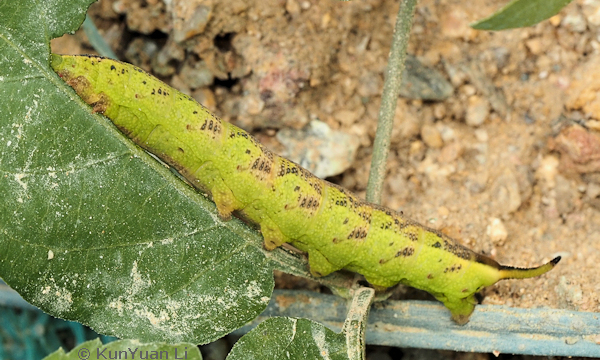
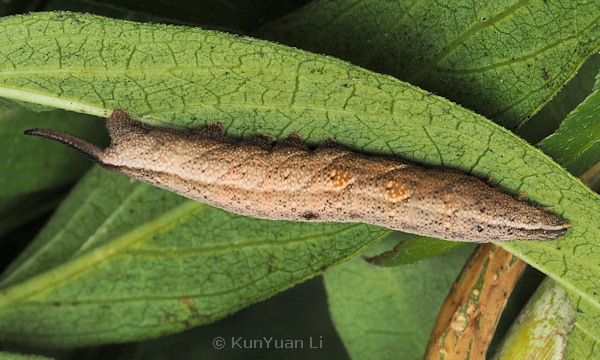
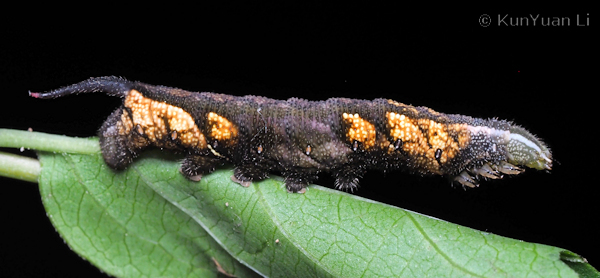
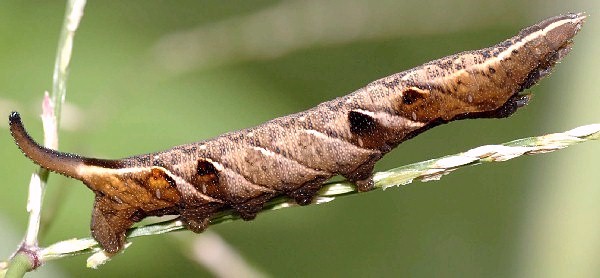
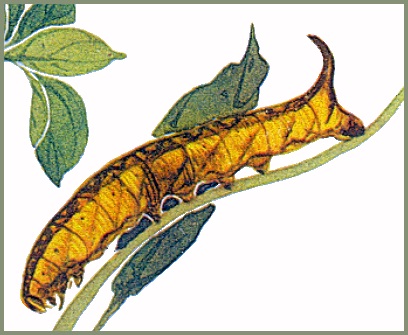
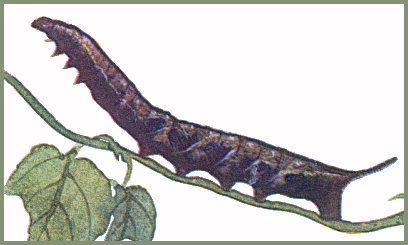
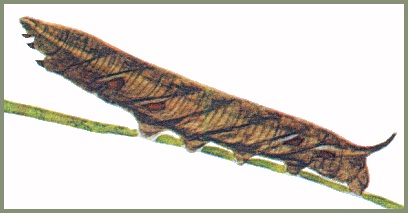


PUPA: 25mm, width 8 mm. Colour very pale bone-yellow; head and thorax so suffused with light fuscous that the ground-colour appears only as irregular lines; wing-case fuscous, the veins only of ground-colour; tongue, antenna and legs transversely barred with fuscous. There is a trapeze formed of four black spots on dorsum of head; a lateral black spot on 2; thorax with a small, black, subdorsal spot and a longitudinal, dorso-lateral series of three black spots; abdomen with a black, broken, dorsal stripe. A broad, transverse, fuscous band is present around the hind margin of 5, 6, 7 and 11; hind bevels of 8, 9 and 10 fuscous; coxal piece, sculpturing on 4, spiracles and shaft of cremaster black, except for the hooks, which are chestnut (Bell & Scott, 1937).
Elongate-ovoid, head bluntly rounded and of less diameter than body; segments 12, 13 and 14 form together an equilateral cone; antenna shorter than fore leg; a narrow coxal piece is present. Surface shiny; head and thorax very superficially lined like cracked lacquer. Abdomen shallowly, sparsely pitted with small pits; sculpturing on segment 4 consisting of a raised, subdorsal, elongate, transverse marking. Eight very narrow, parallel, low ante-spiracular ridges are present on segment 9. Spiracle of 2 a narrow slit covered by a narrow transverse curved lobe projecting from the front margin of 3; other spiracles oval, slightly convex, with a coarse central slit. Cremaster triangular, very short, with a short sub-cylindrical shaft branching into four very short, irregularly disposed branches, each branch ending in two slightly curved hooks (Bell & Scott, 1937).
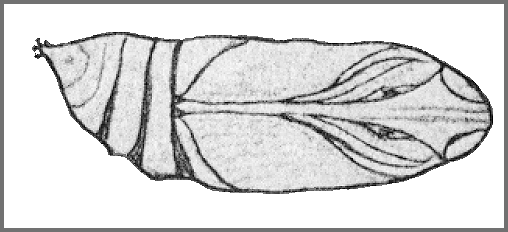
Larval hostplants. Paederia foetida and Serissa japonica [syn. Serissa foetida] (Rubiaceae) in Hong Kong and other parts of southern China -- the latter is often used as an ornamental bonsai shrub. Recorded from Morinda umbellata in Macau (Easton & Pun, 1996) and from Morinda citrifolia on Taiwan. In northeastern India on Paederia foetida and in southern India on various species of Morinda (Bell & Scott, 1937).
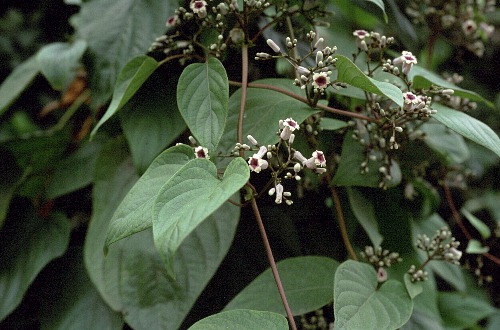
China: Jiangsu (Wuxi); Zhejiang (Tianmu Shan); Hunan (Dayong); Fujian (Longqi Shan); Guangdong (Guangzhou; ??Tai-chung; Wanzishan, Deqing); Macau; Hong Kong (Kowloon; Ping Chau Island); Hainan (Chengmai; Lingao; ??Secha; ??Man-Chyo).
Taiwan: Kaohsiung; Tainan; Tainan Hsien (Kuantzuling, 1000'); Taipei Hsien (Fushan; Wulai); Hualien Hsien (Hungyeh); Nantou Hsien (Lushan Spa); Pingtung Hsien (Kenting); Orchid Island/Botel Tobago.
Japan: Ryukyu Archipelago (Okinawa; Hateruma-jima (Kishida & Shirakawa, 1988)).
India (Chakraborty, Chakraborty, Biswas, Chakraborty & Deb, 2024), Nepal, Bhutan (Irungbam & Irungbam, 2019), Burma/Myanmar, central and southern China, Taiwan, southern Japan, Thailand, Laos (Spitsyn, Burchalovskaia & Spitsyna, 2022), Vietnam, Malaysia (Peninsular), Indonesia (Sumatra, Java), Philippines.
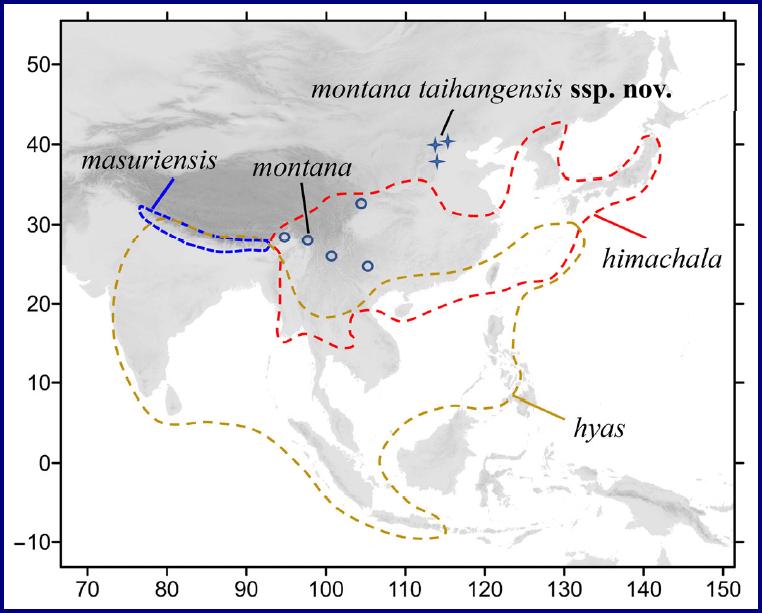
Map: Distribution of species of genus Neogurelca in Asia. The ranges of three species are represented by dashed lines. The blue circles indicate the populations of N. montana montana in Yunnan and Sichuan, the blue stars indicate the populations of N. montana taihangensis in Beijing and Hebei (© Xu, He, Yang, Kitching & Hu, 2023).
 Return to Sphingidae of the Eastern Palaearctic species list
Return to Sphingidae of the Eastern Palaearctic species list